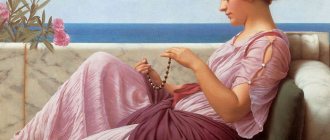According to the standards of sculptors and artists of Ancient Greece, a person's forehead should be low and smoothly merge into the bridge of the nose. There should not be any bridge of the nose, only a slight depression is possible. This is especially noticeable on helmets, where the protective plate was a continuation of the line. The eyes are set deep, so that the main depression is emphasized more clearly.
For the first time, such profiles began to appear during the period of red-figure ceramics. The overall contour has become smoother, the chin has become heavier and shorter, the forehead has narrowed, and the nose has become shorter and straighter. Often such facial features in mythology were endowed with gods and their children, positive heroes.
It is believed that those with a Greek profile have a self-possessed character, do not panic, and have excellent logical thinking. Even today, the ideal nose shape is considered Greek. Therefore, many Hollywood celebrities undergo plastic surgery, trying to fit their faces to ancient beauty standards.
Characteristic features of the Greek nose are:
- the forehead and back form one line,
- there may be a slight depression on the bridge of the nose,
- it should be short, thin and straight,
- male differs from female only in the width of the back,
- the nostrils should not be too wide,
- the tip of the Greek nose does not bend, but is the final point in the line,
- There is no hump on the back.
You can check how close your nose is to ideal using the following parameters:
- it adheres to the surface of the face at an angle of 33-37 degrees,
- the distance between the tip and the upper lip is 94-96 degrees for men, 100 for girls,
- the back should protrude 2.2-2.7 cm,
- length ranges from 5.5 to 6.2 cm.
It is really difficult to find people who have a straight Greek nose. Scientists believe that only gods and mythical heroes were endowed with such a profile and facial features in order to emphasize their ideality. It was a symbol of perfect beauty. When realistic sculptures appeared in Ancient Greece, the Hellenes began to depict their contemporaries as they were in reality.
It became clear that there are no ideal faces. The most famous and best representatives, such as Aristotle, Socrates, Demosthenes and others, had strange and bizarre features. Today, there are isolated cases of a real Greek profile.
You can see a typical male profile in ancient Greek statues, for example, Hermes, Hercules, Zeus. However, it is quite difficult to find contemporaries with classic facial features. Admiral Nelson is considered a striking example of a Greek nose in men.
To read: Fragrant coffee wrap for cellulite
Another is British serial killer Robert Maudsley . , the singers Sakis Rouvas and Dimos Anastasiadis can be called the owner of an almost real Greek profile .
For women, a straight nose was associated with a hairstyle. She emphasized the low forehead, regular and clear facial features. The Greek nose of women differed from men's only in elegance and subtlety. In classical statues, such forms can be observed in Athena, Hera and Artemis.
Modern girls with a Greek nose, singer Elena Paparizou, actresses Ellie Lambeti, Irene Papas . Angelina Jolie, Demi Moore, Monica Bellucci, Natalie Portman underwent plastic surgery and brought their facial features to the ideal
The only way to get a straight Greek nose is rhinoplasty. This is the most popular operation. Most often, people want to make it thin, graceful, straight, reduce the nostrils and straighten the back.
Read more in our article about which nose is considered Greek.
Greek style of clothing for men
Design motifs from ancient Hellas, the land of the gods of Olympus, are still echoed in the latest collections of fashion designers.
Since ancient times, the Greek nation has glorified the beauty of the human body. There was a real cult of good physical shape. The clothing of this country emphasized the exciting curves of the figure of both sexes, although bright colors were not typical for it. The silhouette-lengthening robes often resembled majestic white temples with their strict outlines. Greek clothing for men was spacious - there were capes, cloaks, and under them - loose pants with shirts. However, these days no one wears such things anymore, they are inconvenient and impractical. Modern Greek men wear European-style clothing. Although many people wear national costumes to ancient Greek festivals.
Even with the hot climate inherent in the country, they have always been multi-layered and voluminous. There were always many folds in them where bladed weapons were hidden. The Greeks were in constant wars throughout their history, instantly transforming from peaceful peasants into brave armed partisans.
Greek clothing
The ancient Greeks not only achieved great success in various spheres of culture, but also succeeded in the art of dressing well: they were the first to come to the idea that people in their splendor are like gods, and the human body is a mirror reflecting the ideals of the universe.
The main elements of the national costume in Ancient Greece were: the himation, which was a cape that was draped to emphasize the figure, and the chiton, which was underwear. Based on the moral requirements of that era, clothing for Greek women was longer than men's and covered almost the entire body. It also consisted of a himation and a chiton, but was much more colorful and brighter. However, wearing colorful clothes was not welcomed by the Greeks. To make a single-color outfit more interesting, it was decorated with elaborate patterns and embroidery.
Today, clothing for women in the Greek style is not only part of the country’s history, but also an inspiration for designers and fashion designers from all over the world to create creations of modern fashion art that attract fashionistas with their elegance and lightness.
Beauty and ethics
How to change the shape of your nose
It should be noted that in Ancient Greece it was forbidden to depict a completely naked female body - it was believed that this degraded a woman and looked obscene. That is why many sculptures were covered with design elements carved from stone (parts of clothing and imitation fabric drapery, etc.) and were only partially exposed. Aphrodite of Praxiteles and Aphrodite de Milo remain very rare exceptions to the rule. The authors of these sculptures managed to avoid public condemnation: to prevent these works of art from gaining a bad reputation, the sculptors depicted women during the procedure of preparing for bathing.
What did the ancient Greeks and Romans look like?
If you have ever wondered what people looked like in Ancient Greece, the Roman Empire and other states, then today there is an answer to this question. Modern technologies make it possible to recreate and reconstruct images of ancient people from their remains, or using neural networks, Photoshop and other auxiliary tools.
In this article I have collected reconstructions from several sources.
The idea of the ancient Greeks and Romans has been preserved in art. These are paintings, sculptures and dishes. But, nevertheless, some still believe that the ancient Greeks were light :), despite the huge number of disproving facts. There is also a difference in the way the ancient Greeks depicted humans and gods. The gods were supposed to be different from people; they were depicted with an ideal appearance. But this is not an indication that ordinary mortals looked the same.
When the sculptor needed to make Aphrodite or Apollo, he did not take the first passerby he came across. The selection of the sitter was very careful, and it is unknown how much the sculptor changed some features in order to make them more correct and ideal to his taste. Therefore, sculptures and images of gods are very different from sculptures and portraits of famous Greeks of Ancient Hellas.
Let's see how these people are reflected in art.
In vase paintings, dark-haired people are most often found, but blond hair is a rare exception. These examples indicate precisely that they could show light hair, but made it dark
The Greeks made ideal sculptures of gods and heroes. Here I have indicated sculptures of Apollo, Aphrodite, Hera and Hercules. A small part of them are indicated in the descriptions as fair-haired, but this is only because these gods should be different from people and from some other gods. For example, Aphrodite, as the goddess of beauty, is fair-haired. Sculptures of gods are most often cited as proof that those Greeks no longer exist. Today's Greeks should all look like the gods of antiquity











